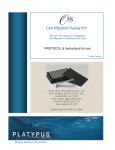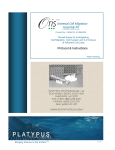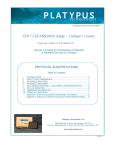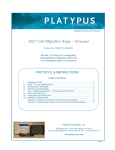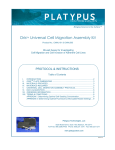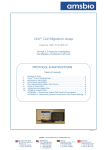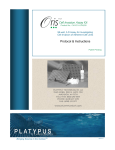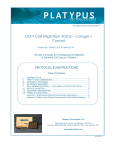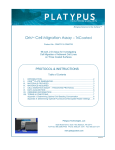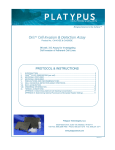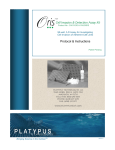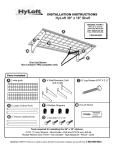Download Cell Migration Assay *
Transcript
Cell Migration Assay * Collagen Coated 96-well, 2-D Assay for Investigating Cell Migration of Adherent Cell Lines PROTOCOL & Instructions for Use * Patent Pending Platypus Technologies, LLC 5520 Nobel Drive, Suite 100 Madison, WI 53711 Toll Free: (866) 296-4455 Phone: (608) 237-1270 Fax: (608) 237-1271 www.pLatypustech.com Bringing Science to the Surface Oris™ CELL MIGRATION ASSAY – COLLAGEN COATED I. INTRODUCTION The Oris™ Cell Migration Assay – Collagen Coated is a reproducible, sensitive, and flexible assay that can be used to monitor cell migration. Formatted for a 96-well plate, the assay utilizes Oris™ Cell Seeding Stoppers (made from a medicalgrade silicone) to restrict cell seeding to the outer annular regions of the wells. Removal of the stoppers reveals a 2mm diameter unseeded region in the center of each well, i.e., the migration zone, into which the seeded cells may then migrate. The Oris™ Migration Mask is applied to the plate bottom and restricts visualization to the migration zones, thus allowing only migrated cells to be detected (see Figure 1). The Oris™ Cell Migration Assay – Collagen Coated is designed to be used with any commercially available stain or labeling technique and the readout can be performed by microscopic examination or by using a plate reader. The Oris™ Cell Migration Assay – Collagen Coated system has been designed for use with adherent cell cultures. This assay has been successfully used with epithelial (T47D, MCF10A, and HeLa) cell lines. Using the Oris™ Cell Migration Assay – Collagen Coated offers the following benefits: • Membrane-free Migration - no transwell inserts • Versatile - analyze data using multiple probes in a single to manipulate well by using a microscope, digital imager, or fluorometer • Reproducible Results - the unique design provides • Flexible - perform kinetic or endpoint cell migration well-to-well CV's < 12% assays without the use of special instrumentation • Preserves Cell Morphology - changes in cell structure • Specific - ability to Study Cell Migration on Extracellular can be monitored in real-time Matrix Surface. Apply Mask and Add Cells to Wells Incubate to Allow Cell Attachment in Outer Annular Region of Wells Remove Stoppers Incubate to Allow Cells to Migrate into Central Migration Zone of Wells Seeded Cells that HAVE NOT Migrated into Central Migration Zone are Blocked from View Observe Migrated Cells Using Microscope or Plate Reader Figure 1. Schematic of Oris™ Cell Migration Assay – Collagen Coated II. PRODUCT SPECIFICATIONS Diameter of Well Diameter of Stopper Space (Migration Zone) Suggested Media Volume per Well (populated with Stoppers) Effective Area of Outer Annular Region (seeding region) per Well Effective Area of Central Migration Zone per Well Well Coating Material Storage Conditions III. MATERIALS PROVIDED IV. MATERIALS REQUIRED 6.5 mm 2 mm 100 µl 30.03 mm2 3.14 mm2 Collagen I, rat-tail Refrigerate (4°C) • One (1) Oris™ Migration Mask • One (1) Oris™ Stopper Removal Tool • One (1) 96-well Collagen Coated Plate with Oris™ Cell Seeding Stoppers • • • • • Biological Cells Cell Culture Medium Sterile PBS Sterile Pipette Tips/Pipette or Multi-Channel Pipette Inverted Microscope (optional) • Fluorescence Microplate Reader (optional) • Cell Labeling Fluorescent Agent (eg., CellTracker™ Green*, Calcein AM) - required if performing assay readout via plate reader. *a product of Molecular Probes/Invitrogen Platypus Technologies® Bringing Science to the Surface pg. 2 V. CELL MIGRATION ASSAY – COLLAGEN COATED PROTOCOL 1. 2. Remove the Oris™ Cell Migration Assay – Collagen Coated from 4°C and place on lab bench for ~1 hour to allow it to equilibrate to room temperature. Visually inspect the bottom of the populated 96-well plate to ensure that the Oris™ Cell Seeding Stoppers are firmly sealed against the bottom of the plate. To inspect the stoppers, turn the plate over and examine the stoppers for sealing (see Figure 2). If sealing is not observed, return the plate to the upright position and use a sterile instrument to gently push the stopper back into the well until sealing is observed. A NOTE: the sealing of the stoppers can be most easily observed if the plate is tipped at an angle and viewed under indirect light looking for the “bullseye” pattern at the bottom of each well. 3. B C Figure 2. Partially Sealed (A), Unsealed (B) , and Completely Sealed (C) Stoppers Aperture Orientation A-1 Corner Chamfer Attachment Lugs Apply the Oris™ Migration Mask to the bottom of the 96-well plate. First Time Users: In order to prevent splashing of well contents, familiarize yourself with the attachment and removal of the Migration Mask before any liquids are placed in the wells. • Orient the chamfered corners of the mask with those of the 96-well plate, ensuring that the A1 corner of the mask is aligned with the A1 well of the plate (see Figure 3). • Align the holes in the attachment lugs with the bosses on the bottom of the 96-well plate. • Gently press the mask until it is flush with the bottom of the 96-well plate. NOTE: It may be necessary to wash the mask with ethanol to remove dust and debris since the mask is not sterile. The mask may be applied at any point during the assay. For kinetic assays, it is often most convenient to apply the mask at the beginning of the assay before any liquids are placed in the well. For endpoint assays, using fixed and stained cells, it is often most convenient to apply the mask just before reading assay results. 4. If performing a kinetic analysis of cell migration, pre-stain cells with a fluorescent stain now. 5. Collect cells and prepare a suspension that is 10-fold greater in density than the optimal seeding concentration. Figure 3. Features of Migration Mask First Time Users: The optimum seeding density of cells must be determined as an integral part of the design of the cell migration assay. Please see Appendix I for a discussion of this process. 6. Pipette 100µl of suspended cells into each test well through one of the side ports of the Cell Seeding Stopper. Figure 4. Media is Added with Single or Multi-Channel Pipette NOTE: For best results, add or extract media by placing the pipette tip along the wall of the well (see Figure 4). Care should be taken not to disturb the Collagen Coating or the Cell Seeding Stopper when introducing the pipette tip into the well. A slender/elongated tip or a gel loading tip may be useful. 7. IMPORTANT: Lightly tap the plate on your work surface to evenly distribute well contents (extreme tapping may result in splashing of well contents and lead to contamination). 8. Incubate the seeded plate containing the Oris™ Cell Seeding Stoppers in a humidified chamber (37 °C, 5% CO2) for 4 to 16 hours (cell line dependent) to permit cell attachment. 9. Remove plate from incubator. 10. Designate several ‘reference’ wells (that will represent t=0) in which the stoppers will remain in place until results are read. 11. Using the Oris™ Stopper Removal Tool, remove all other stoppers (see Figure 5). • Secure the 96-well plate by holding it firmly against the deck of your work space. Slide the tines of the removal tool under the backbone of the stopper strip, keeping the underside of the removal tool flush with the top surface of the plate. • Lift the removal tool vertically to gently remove the stopper. Figure 5. Removal of Stoppers Panels A, B, and C) Position the Tines of the Removal Tool between the Stopper Tips, D) Lift Vertically, and E) Do NOT Pry Stoppers Platypus Technologies® Bringing Science to the Surface pg. 3 NOTE: DO NOT use the removal tool as a lever to pry the stoppers from the well, as doing so may cause displacement of seeded cells. 12. Remove media and gently wash wells with 100µl PBS (or media) to remove any unattached cells. 13. Add appropriate amount of fresh culture media to each well. 14. Incubate plate in a humidified chamber (37 °C, 5% CO2) to permit cell migration. Incubation time will vary depending upon cell type and experimental design. 15. If performing an endpoint analysis of cell migration, apply stain. DATA ACQUISITION The readout of the Oris™ Cell Migration Assay – Collagen Coated can be conducted at any time, allowing the user to perform a kinetic assay or an endpoint assay. The Oris™ Cell Migration Assay – Collagen Coated is designed to be used with any commercially available stain or labeling technique. The readout can be performed by microscopic examination or by using a plate reader. Microscopic Analysis • Cell counting or image capture / analysis (using software, such as Image J freeware, available from NIH) • Note: Microscopic observations are possible using phase contrast or bright field microscopy with colorimetric stains. Plate Reader Analysis • Setup on individual plate readers varies according to make and model. Consult your user manual for proper operation. • The plate reader MUST be set to use the bottom probe read. 6 • Sample Data using a fluorescent stain is shown below. Wells were seeded with 100,000 T47D cells/well (i.e., 100 µl of 1x10 cells/mL) and the plate was incubated for 24 hours. The stoppers were then removed from test wells, but remained in place in the pre-migration reference wells until the time of the assay readout. Cells were fluorescently stained with Calcein AM. The seeded plate was incubated in a humidified chamber for 24 hours and readout was conducted via a plate reader. The images below, captured with a migration mask in place, illustrate representative data from pre-migration (t=0 hrs) and post-migration (t = 24 hrs) wells. Note that a minimal amount of signal is provided at t=0 in order to reduce the threshold limit for detection of input to the plate reader and permit detection of early cell migration events in the migration zone. The graph depicts the average fluorescence signal +/- SEM in the migration zones for each condition (n= at least 39 wells/condition). 24 Hour Endpoint Detection of T47DCell CellMigration Migration into into Analytic Zone T47D Migration Zone Pre-Migration (t=0 hrs) Relative Fluorescence Units VI. 1500 1300 1100 900 700 500 Pre-Migration Post-Migration (t=24 hrs) Post-Migration Migration Condition Platypus Technologies® Bringing Science to the Surface pg. 4 VII. ORDERING INFORMATION Product No CMA1.101 CMA5.101 CMACC1.101 CMACC5.101 Product Description Oris™ Cell Migration Assay, 1-pack: (1) Oris™ 96-well plate (black, clear bottom) with Oris™ Cell Seeding Stoppers (1) Oris™ Migration Mask & (1) Oris™ Stopper Removal Tool Oris Cell Migration Assay, 5-pack: (5) Oris™ 96-well plates (black, clear bottom) with Oris™ Cell Seeding Stoppers (1) Oris™ Migration Mask & (1) Oris™ Stopper Removal Tool Oris Cell Migration Assay - Collagen Coated, 1-pack: (1) Oris™ Collagen I Coated, 96-well plate (black, clear bottom) with Oris™ Cell Seeding Stoppers (1) Oris™ Migration Mask & (1) Oris™ Stopper Removal Tool Oris Cell Migration Assay - Collagen Coated, 5-pack: (5) Oris™ Collagen I Coated, 96-well plates (black, clear bottom) with Oris™ Cell Seeding Stoppers (1) Oris™ Migration Mask & (1) Oris™ Stopper Removal Tool Package Size 1-pack 5-pack 1-pack 5-pack To place an order, visit the Platypus Technologies website at: www.platypustech.com/order_main.html For technical assistance, contact Technical Support at (866) 296-4455 or [email protected] VIII. TERMS & CONDITIONS Certain uses of these products may be covered by U.S. Pat. No. 6,284,197, No. 7018838, No. 10/597,118, No. 11/342,413, and No. 60/836,109, licensed to PLATYPUS. Certain applications of PLATYPUS products may require licenses from other parties. Determining the existence and scope of such third party intellectual property is the responsibility of the PURCHASER. Purchase of the product provides the PURCHASER with a limited non-transferable license under any PLATYPUS patents or patent applications to use the product for internal research unless there is a written limitation to this license in the product literature. PURCHASER is responsible for carefully reviewing the product literature and respecting any limitations to this license, e.g. limitations for commercial use or research by for-profit institutions. These products may not be resold, modified for resale, used to manufacture commercial products, or used to develop commercial products without the express written approval of PLATYPUS. These products are intended for research or laboratory use only and are not to be used for any other purposes, including, but not limited to, unauthorized commercial purposes, in vitro diagnostic purposes, ex vivo or in vivo therapeutic purposes, investigational use, in foods, drugs, devices or cosmetics of any kind, or for consumption by or use in connection with or administration or application to humans or animals. PLATYPUS warrants that its products shall conform substantially to the description of such goods as provided in product catalogues and literature accompanying the goods until their respective expiration dates or, if no expiration date is provided, for 6 months from the date of receipt of such goods. PLATYPUS will replace, free of charge, any product that does not conform to the specifications. This warranty limits PLATYPUS's liability only to the replacement of the nonconforming product. THIS WARRANTY IS EXCLUSIVE AND PLATYPUS MAKES NO OTHER WARRANTY, EXPRESS OR IMPLIED, INCLUDING WITHOUT LIMITATION, ANY IMPLIED WARRANTY OF MERCHANTABILITY OR FITNESS FOR A PARTICULAR PURPOSE. The stated express warranties, and the remedy provided for breach thereof, are in lieu of all other liability or obligations of PLATYPUS for any damages whatsoever arising out of or in connection with the delivery, use, misuse, performance, or the inability to use any of its products. IN NO EVENT SHALL PLATYPUS BE LIABLE UNDER ANY LEGAL THEORY (INCLUDING BUT NOT LIMITED TO CONTRACT, NEGLIGENCE, STRICT LIABILITY IN TORT, OR WARRANTY OF ANY KIND) FOR ANY INDIRECT, SPECIAL, INCIDENTAL, CONSEQUENTIAL, OR EXEMPLARY DAMAGES (INCLUDING BUT NOT LIMITED TO LOST PROFITS) EVEN IF PLATYPUS HAD NOTICE OF THE POSSIBILITY OF SUCH DAMAGES. Without limiting the effect of the preceding sentence, PLATYPUS's maximum liability, if any, shall not exceed the purchase price paid by PURCHASER for the product. This warranty shall not be effective if PLATYPUS determines, in its sole discretion that PURCHASER has altered or misused the goods or has failed to use or store them in accordance with instructions furnished by PLATYPUS. PLATYPUS’s sole and exclusive liability and PURCHASER’s exclusive remedy with respect to goods proved to PLATYPUS’s satisfaction (applying analytical methods reasonably selected by PLATYPUS) to be defective or nonconforming shall be the replacement of such goods free of charge, upon the return of such goods in accordance with our instructions, although at its discretion, PLATYPUS may provide a credit or refund. If PLATYPUS manufactures custom goods for PURCHASER based on instructions, specifications, or other directions provided by PURCHASER, PLATYPUS shall not be liable for the lack of sufficiency, fitness for purpose or quality of the goods to the extent attributable to such instructions, specifications, or other directions. PLATYPUS shall not be liable for any loss, damage or penalty as a result of any delay in or failure to manufacture, deliver or otherwise perform hereunder due to any cause beyond PLATYPUS’s reasonable control. PLATYPUS shall not be liable for injury or damages resulting from the use or misuse of any of its products. For a comprehensive list of Platypus’s Terms & Conditions, access www.platypustech.com/products/termsconditions.html. Platypus Technologies® Bringing Science to the Surface pg. 5 APPENDIX I: Determining Optimal Cell Seeding Concentration This appendix is intended to assist in determining the cell seeding density needed to achieve confluency of your cell line when using the Oris™ Cell Migration Assay – Collagen Coated. To that end, several dilutions of cell suspensions will be investigated. NOTE: The Oris™ Migration Mask MUST be removed from the 96-well plate prior to the start of the following steps: 1. 2. 3. Collect cells and calculate total number of cells. Pellet cells by centrifugation and resuspend to a final concentration of 500,000 cells/mL in culture media. Seed a 100 µl portion of cells, at 2-fold serial dilutions in the 96-well plate starting at 50,000 cells/well (a suggested starting amount), as shown below. Keep in mind that the cell seeding area of the well with the stopper in place is ~ 0.3 cm2 and based on the typical seeding density of your cells, you can infer the appropriate cell number for your first serial dilution. Column 2 3 4 Cells / well 50,000 25,000 12,500 Number of wells 6 6 6 4. Incubate the plate in a humidified chamber (37°C, 5% CO2) for 4-16 hours (cell line dependent) with cell seeding stoppers in place. Following cell attachment, remove the Oris™ Cell Seeding Stoppers from each well (see Figure 6) and gently wash the wells with PBS to remove non-adhered cells. • Secure the 96-well plate by holding it firmly against the deck of your work space. Slide the tines of the removal tool under the backbone of the stopper strip, keeping the underside of the removal tool flush with the top surface of the plate. • Lift the removal tool vertically to gently remove the stopper. Do not use the removal tool as a lever to pry the stoppers from the well as doing so may cause displacement of the seeded cells. Use a microscope to visually inspect the cells and determine the cell seeding concentration that yields a confluent layer. 5. 6. NOTE: If you plan to obtain the results of the Oris™ Cell Migration Assay – Collagen Coated via colorimetric or microscopic analysis, you have successfully determined the optimal cell seeding concentration for your cell line. Proceed to Step 2 of the Cell Migration Assay – Collagen Coated Protocol. If you plan to obtain the results of the Oris™ Cell Migration Assay – Collagen Coated via a fluorescence plate reader, proceed with the following steps to optimize your plate reader settings. 7. 8. 9. The Oris™ Cell Migration Assay – Collagen Coated has been designed to work with all types of fluorescence stains and staining techniques. The precise method for staining cells with fluorescence stains varies according to the nature of the individual stain. Please consult the manufacturer of your fluorescence stain for specific considerations. First Time Users: For a guide to using Calcein AM, see below: a) Aspirate media from wells & wash wells with PBS or media. b) Add 100 µl of Calcein AM to each well at an appropriate concentration [for a fully-seeded 96-well plate, combine 5 µl of reconstituted Calcein AM (1mg/mL in dry DMSO) with 10 mL of serum-free media or 1x PBS]. c) Incubate plate at 37 °C for 20 minutes. d) Remove plate from incubator. e) Aspirate staining solution. f) Fix cells, or to prevent drying, add 100 µl of 1x PBS to each well. Apply the Oris™ Migration Mask to the plate. Using the bottom probe of a fluorescence plate reader, obtain the total output from each well (adjust the gain settings to achieve optimal dynamic range). To determine optimal dynamic range, consider the following factors: a) The gain setting that permits detection of the lowest concentration of cells. b) The gain setting that permits discrimination between cell numbers at higher densities. NOTE: When using a plate reader to analyze the Oris™ Cell Migration Assay – Collagen Coated, it is important to stain cells using a fluorescence reagent that uniformly stains cells. The use of a fluorescence probe that is affected by experimental conditions will increase variability of results and reduce correlation between fluorescence signal and cell migration. Fluorescence probes that are affected by experimental conditions could be utilized, however, as counterstains for the study of factors and processes affecting cell migration. You have successfully determined the optimal cell seeding concentration for your cell line. Proceed to Step 2 of the Cell Migration Assay – Collagen Coated Protocol. Platypus Technologies® Bringing Science to the Surface pg. 6






